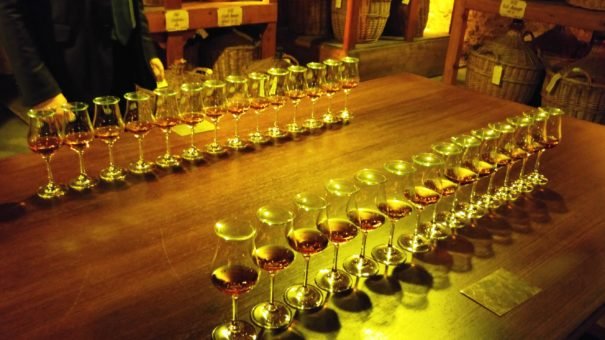
It’s Strangely Fun to Hear Cognac People Losing Their Minds Over Really Old Cognac

It’s Strangely Fun to Hear Cognac People Losing Their Minds Over Really Old Cognac
Cognac in Paradis
There’s a locked room beneath the Martell facility in Cognac, France, holding three centuries worth of secrets. A single dimly lit, nondescript hall, echoing with the faint whispers of passersby, offers its only means of entrance. Or escape.
It’s no prison, though: it’s the Paradis, the cellar where the oldest, finest eaux-de-vie are carefully kept as years, decades, and lifetimes continue to come and go above. Each producer has their own Paradis, but few can lay claim to one as magnificent as Martell’s, the oldest continually operational major Cognac house, founded in 1715. Here, Paradis is the Chai Jean Martell, or Jean Martell Cellar, and the oldest remaining eau-de-vie stretches back to 1802.
The eaux-de-vie, which isn’t known as Cognac until it’s blended, have been aged for exceedingly long periods before being transferred to nonreactive glass vessels known as demijohns, which stop the aging process and keep the spirit intact indefinitely. Kept within seemingly innocuous wicker baskets, which would otherwise be useful for no more than toting around laundry, they instead offer a time-bending, transformative journey to the lucky souls who encounter them.
Each demijohn holds a unique story, a moment locked in time for eternity. One’s story begins on May 30th, 1848, and I would find out later as I searched for some sort of historical significance to the time that was superior to simply stating that it had been over 167 fucking years since the stuff was made, that this is apparently the very same day that the Treaty of Guadalupe Hidalgo, which ended the Mexican-American War, became effective, and that Wisconsin became the 30th state a day prior.
On that day, one particular eau-de-vie was distilled. It then spent 65 years maturing in the cask before being transferred to its state of dormant demijohn deep sleep. Something about this eau-de-vie was deemed worthy of safekeeping, of locking away in Paradis, until some lucky schmuck was able to stroll past in 2015 and attempt to ineloquently link it to something like the Treaty of Guadalupe Hidalgo.
Reading a book is supposedly a means of transporting you to the past, but it’s not sensory in any way, it’s entirely up to the imagination. A great author may be able to conjure up an immersive world for a reader, but nothing is ever actually experienced.
Raise a glass of eau-de-vie distilled in 1848 to your nose, though, and there’s no imagination necessary. Its smell and taste, its appearance in the glass, the feel of it along your tongue and cheeks, all of this came to be thanks to some craftsman’s hands 167 years prior and is now there for you, ready to deliver the innate imbibing pleasure which always rested within.
It’s musty and oaky, dry and spicy, but with fruity and floral notes as well, a delicate interplay belying its incredible age and the multi-century journey the spirit took until the day it was finally enjoyed as intended, November 4th, 2015. The room fills with a flowing, blissful energy, a crazy state of excitement and wonder passes from person to person, as a buzz created in 1848 comes to fruition and is brought to life 61,153 days later for you and your friends. Paradis.